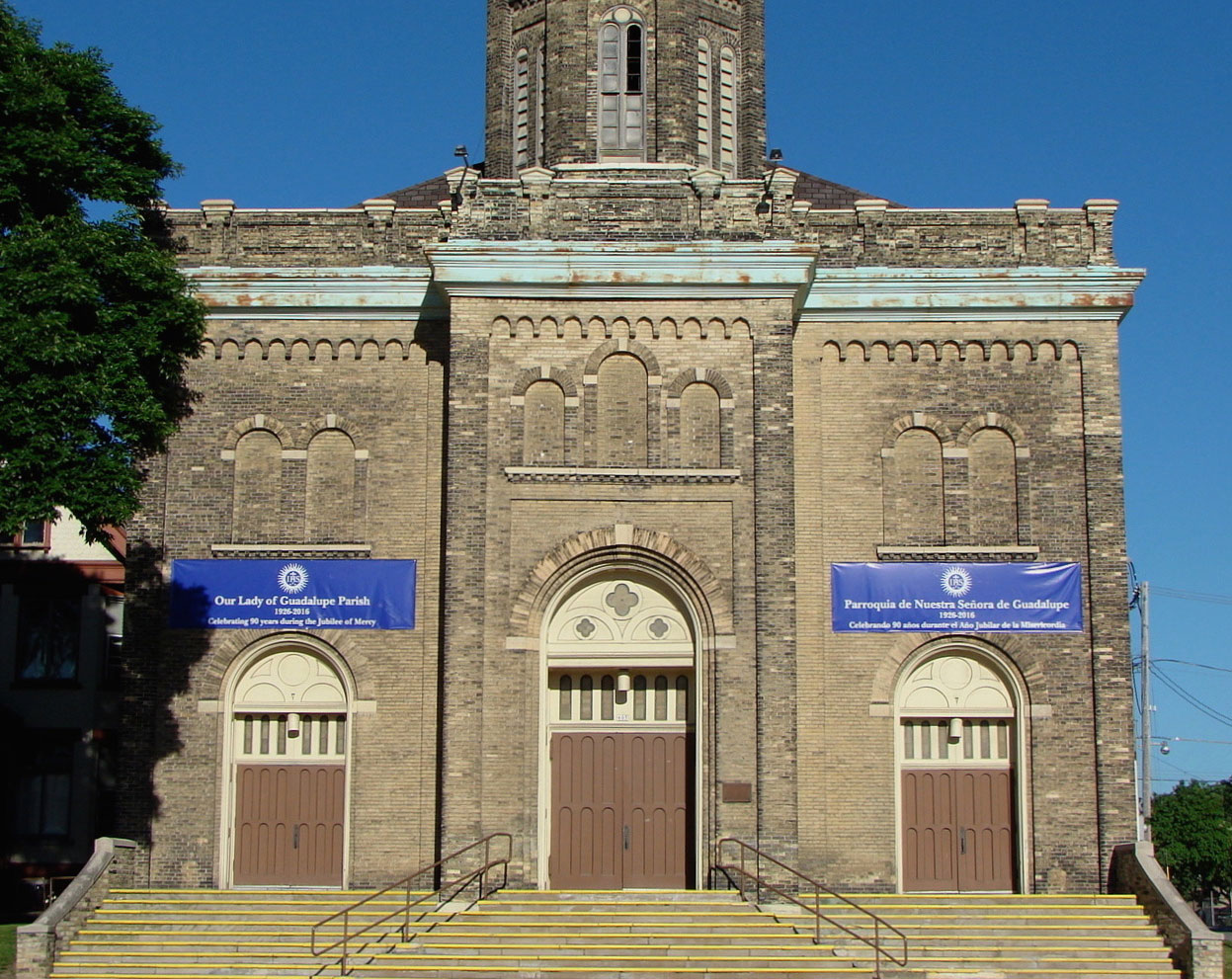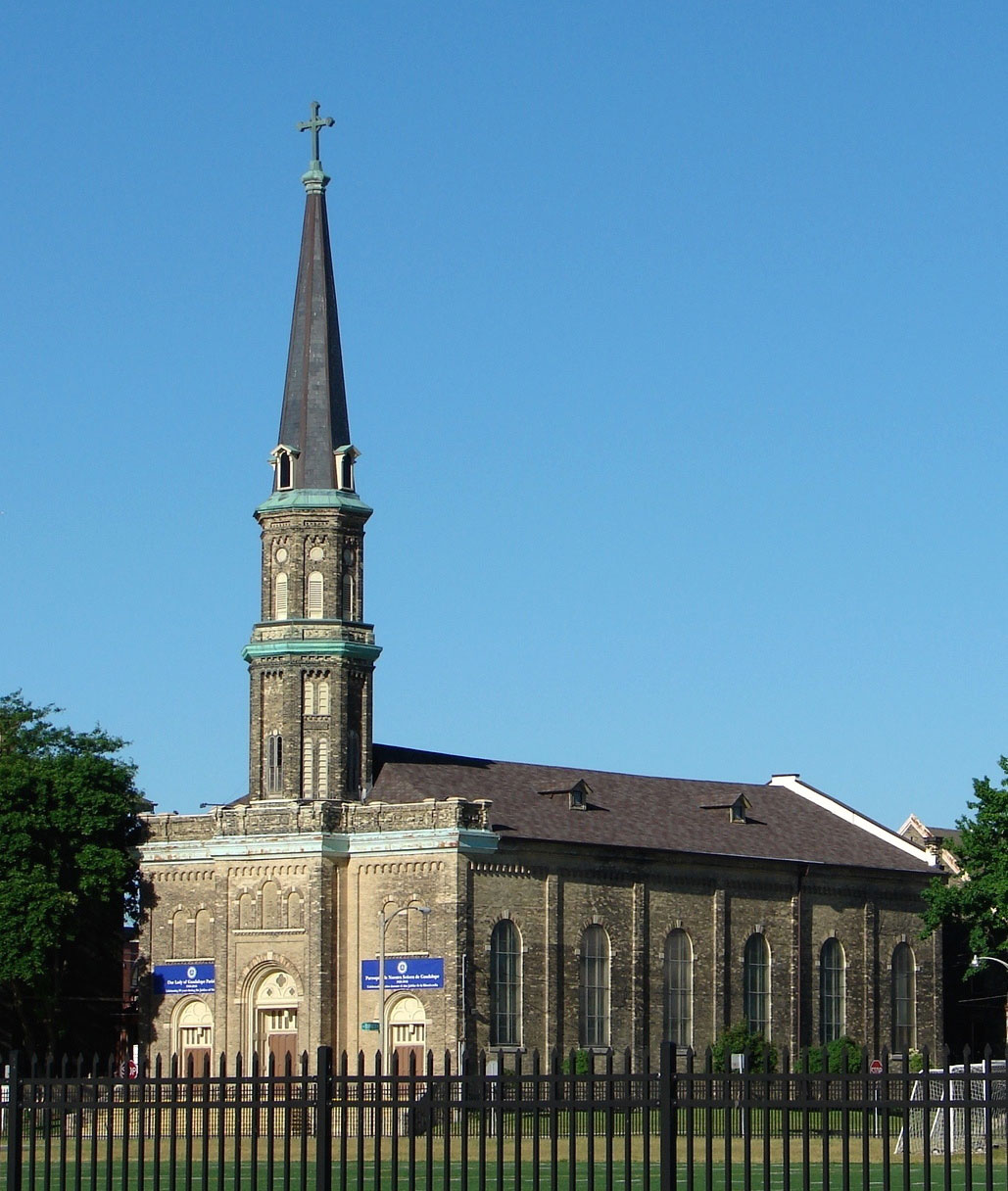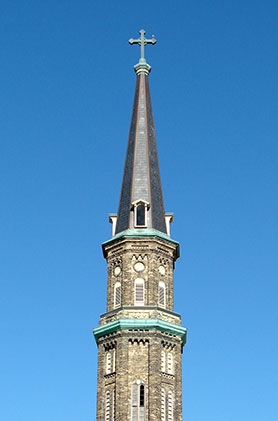3. Holy Trinity Catholic, 1849
Now Our Lady of Guadalupe Catholic
605 South 4th Street (at Bruce Street)
Architect: Victor Schulte
The Catholic Church established a third parish in Milwaukee in response to the growing number of German-speaking Catholics on the city’s South Side. Victor Schulte, the architect of both St. Mary’s and St. John’s, was again commissioned to design Holy Trinity. Construction began in 1849, with dedication of the completed church in September of 1850. The first parishioners were primarily immigrants from Austria and the southern states of the German Confederation.
Like the city’s two older Catholic churches, Holy Trinity is constructed of Cream City brick and exhibits the restrained classicism of the German Zopfstil. It is the plainest of these three early churches, with decorative embellishment limited to the corbeled arcades of brick just below the cornice and at the top of each stage of the tower. The shallow pilasters lack bases or capitals, and there is very little stone trim. Another similarity with St. Mary’s and St. John’s is that the present tower and steeple are not original. The church originally had a small belfry, which was replaced by the current octagonal tower and steeple in 1862.

Services at Holy Trinity were conducted primarily in German through the nineteenth century, with both English and German services during the first quarter of the twentieth century. Instruction at the parish school was also in German initially, with some instruction in English by 1890 or a bit earlier. At the time of the First World War, more English-language services were conducted at the church and instruction in the school switched entirely to English. This was a common occurrence at German Catholic and Lutheran churches throughout the city. With the outbreak of the war, many German-American immigrants wanted to show their loyalty to the United States (and avoid being the targets of anti-German hostility) by adopting English and hastening their assimilation into the American mainstream.
In the 1920s, the growing number of Spanish-speaking Catholics living on the South Side led to the introduction of services in Spanish at Holy Trinity. Priests from Chicago celebrated Mass in the assembly room of the parish school. These visiting priests also heard confessions and performed baptisms and other sacraments for the Spanish-speaking members of the parish. The archdiocese established Our Lady of Guadalupe in 1929, first as a mission church of Holy Trinity and later as a separate parish. Located about six blocks from Holy Trinity, Our Lady of Guadalupe was the first Spanish-language church of any denomination in Milwaukee. In the mid-1960s, with membership declining at Holy Trinity and increasing at Our Lady of Guadalupe, the two parishes merged, with religious services at the older church. By the end of the 1970s, 90 percent of the parishioners were of Latin American origin or ancestry. For some time after the merger, the church took the hyphenated name of Holy Trinity – Our Lady of Guadalupe, but is now known simply as Our Lady of Guadalupe Catholic Church.
Sources:
Album Directory: Holy Trinity – Our Lady of Guadalupe Church. Le Mann & Associates, 1971.
Bruce, William G. Holy Trinity Church, 1850-1925. Holy Trinity Church, 1925.
__________. The Story of Holy Trinity Parish, 1850-1950. Holy Trinity Church, 1950.
“Church of the Holy Trinity,” Milwaukee Sentinel, October 5, 1874, page 8, column 2.
Holy Trinity – Our Lady of Guadalupe, Milwaukee, Wisconsin. Holy Trinity – Our Lady of Guadalupe Church, c. 1975.
Johnston, James M. “Holy Trinity Served a Variety of Ethnics,” Milwaukee Sentinel, March 4, 1978, part 1, page 7, column 1.
“Many Costly Renovations,” Milwaukee Sentinel, October 29, 1888, page 3, column 2.
Pokorny, Gary. “Ministry to Hispanics in the Archdiocese of Milwaukee” in Milwaukee Catholicism, edited by Steven M. Avella. Knights of Columbus, 1991.

